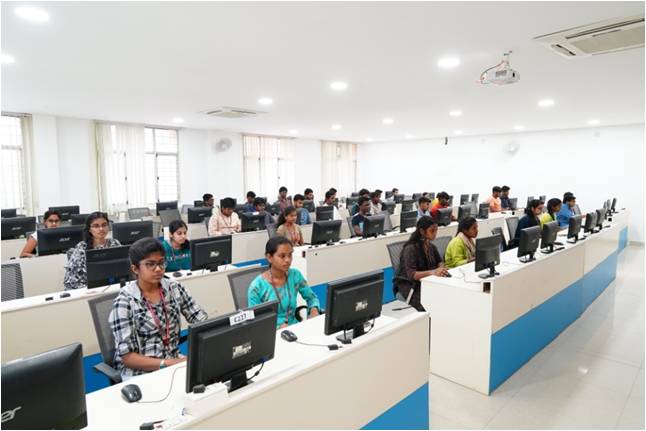Infrastructure
Infrastructure
Laboratories
PPS - I, I Yr-I Sem
Description: Programming for Problem Solving-I (PPS-I), as name suggests allows students to experience problem solving through programming using various platforms, especially through C programming language. This course introduces basic programming constructs in C language upto arrays and functions. It also discusses some of the searching and sorting algorithms .
Outcome of the Lab: Students able to solve Problem ,learn basics of programming, various control statements, usage of arrays and functions, implementing searching and sorting algorithms using C.
PPS - II, I Yr-II Sem
Outcome of the Lab: String handling functions – both predefined and user defined, structures, pointers, dynamic memory allocation, data structures: stack and queue, basic operations on linked lists, file handling in C.
Data Structure & Python Lab, II Yr-I Sem
Description:Data structures concepts Linked list , trees ,graphs and hashing techniques are present and in Python is an interpreted, a general purpose ,and high level programming language. It allows you to focus on core functionality of the application by taking care of common programming tasks. It allows us to develop applications using an Object Oriented approach.
Outcome of the Lab: Students able to write the programs for trees , graphs and hashing in DS and in python Use various Control statements, string manipulations and to Perform list and dictionaries operations in python. Object oriented programming features are used to solve the complex problems
JAVA Lab, II Yr-II Sem
Description:Data structures concepts Linked list , trees ,graphs and hashing techniques are present and in Python is an interpreted, a general purpose ,and high level programming language. It allows you to focus on core functionality of the application by taking care of common programming tasks. It allows us to develop applications using an Object Oriented approach.
Outcome of the Lab: Students able to write the programs for trees , graphs and hashing in DS and in python Use various Control statements, string manipulations and to Perform list and dictionaries operations in python. Object oriented programming features are used to solve the complex problems
DBMS Lab, II Yr-II Sem
Description:A database management system is computer application software that provides a way to manage data. The requirement of modern days is to have an automated system that manages modifies and updates data accurately. This is achieved by DBMS in robust, correct and non redundant way. DBMS lab aims at practicing and achieving this aim by using various software’s such as MYSQL,ORACLE etc.
Outcome of the Lab: By using the SQL commands such as DDL,DML,DCL able to create tables with integrity constraints ,manipulate data ,access data from database and able to design, implement pl/sql programs which includes procedures,cursors ,functions and triggers.
CN&OS Lab , III Yr-I Sem
Description:
In OS lab implements concepts of operating systems such as, CPU scheduling, process management,
memory management, file systems and deadlock handling using C language. Computer networks lab consists of layers , error detection and error correction algorithms and different routing algorithms to find the minimum distance among different routers.
Outcome of the Lab: Students able to implement scheduling algortims, deadlock handling, CRC algorithms, routing algorithms.
WT Lab, III Yr-I Sem
Description:In WT Lab using HTML ,CSS develop the validation forms and java server pages are developed.
Outcome of the Lab: Student able to develop static and dynamic web applications.
DM&CT Lab, III Yr-II Sem
Description:
The main objective of this DM lab is to impart the knowledge on how to implement classical models and algorithms in data warehousing and data mining by using WEKA Tool.In Real world data consists of noisy and inconsistent data due to their size so that data pre-processing is applied to remove data inconsistency. In Data mining Association rules are used to discover the related patterns in the given data, Classification techniques are used to find the model for the purpose of prediction and clustering is used for grouping the similar objects and in CASE tools using tools model the UML diagrams.
Outcome of the Lab: In DM lab mining algorithms as a component to the existing tools and able to apply mining techniques for realistic data and for case Tools illustrate /using various tools model the various uml diagrams.
IoT Lab (Professional Elective), IV Yr-I Sem
Description:IoT Lab helps the students in providing a good learning environment and also work with real time problems faced in day to day life. It also enhances collaborative learning and also will help in getting much knowledge in multidisciplinary streams irrespective of the course taken by them.
Outcome of the Lab: Each team coming up with some idea will are supposed to have a brain storming session and the idea has to be presented to the rest of the teams and then students start working with the design and also various components that are supposed to be used and any other cost reducing alternative which are present and then only the students work in a modular way and the final output is obtained.
Big Data Analytics Lab(Professional Elective), IV Yr-I Sem
Description:The main objective of this lab is to impart the knowledge on how to implement basic data structure programs and Installing Hadoop in different operating modes, able to run Hadoop commands and sample Map Reduce programs to explore the HDFS on the Hadoop system. Able to explore the knowledge of Pig Latin, Hive & Hbase.
Outcome of the Lab: Students are able to do Haddop commands and map reduce problems
Image Processing Using SCI Lab (Professional Elective), IV Yr-I Sem
Description:The main objective of this lab is to impart students the knowledge about:
Image formation and the role human visual system plays in perception of gray and color image data. Get broad exposure to and understanding of various applications of image processing in industry,medicine, and defense.
Signal processing algorithms and techniques in image enhancement and image restoration. Acquire an appreciation for the image processing issues and techniques and be able to apply these techniques to real world problems.
Outcome of the Lab: Students be able to conduct independent study and analysis of image processing problems and techniques.
MAD Lab, IV Yr-I Sem
Description:Specifically it is required to design and implement a system that consists mainly of a mobile client (MC) and a Emulator. MC will be written in XML while Emulator will be written in standard Java.It is to use a mobile phone emulator to develop and demonstrate the experiments.
Outcome of the Lab: In this lab, a student is expected to design, implement, document and present a mobile client/server system using standard Java and Andriod Application platform.

Computer lab -I

Computer lab - 3

Computer lab - 5

Computer lab - 7

Computer lab - 9

Computer lab - 11

Computer lab - 2

Computer lab -4

Computer lab - 6

Computer lab - 8

Computer lab - 10





















